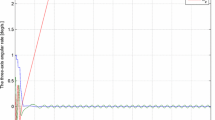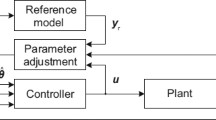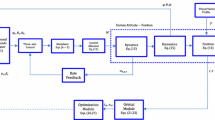Abstract
A new three-axis detumbling mode control approach, namely TADC in the present research, is investigated to deal with a spacecraft, in a short period of time. In a word, the study considers the problem of detumbling by means of system modelling, while the proposed control approach in agreement with the simulation results can be of novelty with respect to the other related potential benchmarks. The approach proposed here plays an important role in this area to adjust angular velocities in the three axes regarding the system under control to be desirable. In some cases, to guarantee the system stability in the process of missions, the whole of angular velocities are to be accurate. In fact, it aims us to organize a number of programmed maneuvers including the orbital, the thermal and so on to be efficient. The idea behind the approach is organized in line with a linear control approach, since the pulse-width pulse-frequency modulator is employed in association with the control allocation to cope with a set of on–off thrusters. Hereinafter, the number of these on–off thrusters may be increased with respect to the investigated control laws to provide overall accurate performance of the spacecraft through the control allocation. The effectiveness of the approach investigated here is finally considered by organizing four scenarios of the experiments and also comparing the outcomes with a number of potential benchmarks.















Similar content being viewed by others
References
Lin Y-Y, Wang C-T (2014) Detumbling of a rigid spacecraft via torque wheel assisted gyroscopic motion. Acta Astronaut 93:1–12
Ovchinnikova MY, Roldugin DS, Penkov VI (2012) Asymptotic study of a complete magnetic attitude control cycle providing a single-axis orientation. Acta Astronaut 77:48–60
Santana AC, Martins-Filho LS, Arantes G Jr (2008) Attitude stabilization of the PMM satellite using a LQG-based control strategy. TEMA Trends Appl Comput Math 9(2):321–330. doi:10.5540/tema.2008.09.02.0321
Zhang W, Zeng J, Li Y (2013) A review of vehicle system dynamics in the development of high-speed trains in China. Int J Dyn Control 1(1):81–97
Farid Y, Moghaddam TV (2014) Generalized projective synchronization of chaotic satellites problem using linear matrix inequality. Int J Dyn Control 2(4):577–586
Sabatini M, Palmerini GB, Leonangeli N, Gasbarri P (2014) Analysis and experiments for delay compensation in attitude control of flexible spacecraft. Acta Astronaut 104(1):276–292
Sidi MJ (1997) Spacecraft dynamics and control, a practical engineering approach, vol 7. Cambridge University Press, Cambridge
Zipfel PH (2000) Modeling and simulation of aerospace vehicle dynamics. AIAA, USA
Zheng Z, Song S (2014) Autonomous attitude coordinated control for spacecraft formation with input constraint, model uncertainties, and external disturbances. Chin J Aeronaut 27(3):602–612
Yang H, You X, Xia Y, Liu Z (2014) Nonlinear attitude tracking control for spacecraft formation with multiple delays. Adv Space Res 54(4):759–769
Huo X, Qinglei H, Xiao B (2014) Finite-time fault tolerant attitude stabilization control for rigid spacecraft. ISA Trans 53(2):241–250
Du H, Li S (2014) Attitude synchronization control for a group of flexible spacecraft. Automatica 50(2):646–651
Song Z, Li H, Sun K (2014) Finite-time control for nonlinear spacecraft attitude based on terminal sliding mode technique. ISA Trans 53(1):117–124
Lu K, Xia Y (2013) Adaptive attitude tracking control for rigid spacecraft with finite-time convergence. Automatica 49(12):3591–3599
Yang Y (2012) Spacecraft attitude determination and control: quaternion based method. Annu Rev Control 36(2):198–219
Zou A-M, Kumar KD (2011) Adaptive fuzzy fault-tolerant attitude control of spacecraft. Control Eng Pract 19(1):10–21
Qinglei H, Li B, Zhang Y (2013) Robust attitude control design for spacecraft under assigned velocity and control constraints. ISA Trans 52(4):480–493
Cai H, Huang J (2014) The leader-following attitude control of multiple rigid spacecraft systems. Automatica 50(4):1109–1115
Kuo Y-L, Wu T-L (2012) Open-loop and closed-loop attitude dynamics and controls of miniature spacecraft using pseudowheels. Comput Math Appl 64(5):1282–1290
Zhang X, Liu X, Zhu Q (2014) Attitude control of rigid spacecraft with disturbance generated by time varying exosystems. Commun Nonlinear Sci Numer Simul 19(7):2423–2434
Erdong J, Xiaolei J, Zhaowei S (2008) Robust decentralized attitude coordination control of spacecraft formation. Syst Control Lett 57(7):567–577
Bustan D, Pariz N, Sani SKH (2014) Robust fault-tolerant tracking control design for spacecraft under control input saturation. ISA Trans 53(4):1073–1080
Lu K, Xia Y, Fu M (2013) Controller design for rigid spacecraft attitude tracking with actuator saturation. Inf Sci 220(20):343–366
Pukdeboon C, Zinober ASI (2012) Control Lyapunov function optimal sliding mode controllers for attitude tracking of spacecraft. J Frankl Inst 349(2):456–475
Yongqiang J, Xiangdong L, Wei Q, Chaozhen H (2008) Time-varying sliding mode controls in rigid spacecraft attitude tracking. Chin J Aeronaut 21(4):352–360
Wu J, Liu K, Han D (2013) Adaptive sliding mode control for six-DOF relative motion of spacecraft with input constraint. Acta Astronaut 87:64–76
Jiang Y, Hu Q, Ma G (2010) Adaptive backstepping fault-tolerant control for flexible spacecraft with unknown bounded disturbances and actuator failures. ISA Trans 49(1):57–69
Butyrin SA, Makarov VP, Mukumov RR, Somov Y, Vassilye SN (1997) An expert system for design of spacecraft attitude control systems. Artif Intell Eng 11(1):49–59
Hu Q, Zhang J (2014) Relative position finite-time coordinated tracking control of spacecraft formation without velocity measurements. ISA Trans. Corrected Proof, Available online 27 August (in press)
Krovel T (2005) Optimal tuning of PWPF modulator for attitude control. Master’s thesis, Norwegian University of Science and Technology, Trondheim, Norway
Johansen TA, Fossen TI (2013) Control allocation—a survey. Automatica 49(5):1087–1103
Zaccarian L (2009) Dynamic allocation for input redundant control systems. Automatica 45(6):1431–1438
Servidia PA (2010) Control allocation for gimballed/fixed thrusters. Acta Astronaut 66(3–4):587–594
Acknowledgments
The corresponding author would like to express all the best and the warmest regards to the respected Editor of ‘International Journal of Dynamics and Control (IJDY)’, Springer Publisher, as well as the whole of respected potential reviewers, for suggesting their impressive, constructive and technical comments on the present investigation. Afterwards, Dr. Mazinan is highly grateful to the Islamic Azad University (IAU), South Tehran Brach, Tehran, Iran in support of the present research, which is carried out under contract with the Research Department of the IAU, South Tehran Brach. And also he appreciates Mrs. Maryam Aghaei Sarchali, Miss Mohadeseh Mazinan and finally Mr. Mohammad Mazinan for their sufficient supports in the process of paper investigation and organization.
Conflict of interest
The authors declare that there is no conflict of interest.
Author information
Authors and Affiliations
Corresponding author
Rights and permissions
About this article
Cite this article
Mazinan, A.H., Khalaji, A.R. TADC: a new three-axis detumbling mode control approach. Int. J. Dynam. Control 5, 337–346 (2017). https://doi.org/10.1007/s40435-015-0184-z
Received:
Revised:
Accepted:
Published:
Issue Date:
DOI: https://doi.org/10.1007/s40435-015-0184-z




